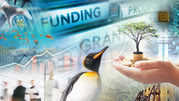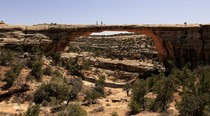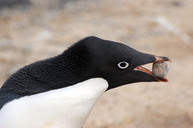 Welcome back to NSF Quarterly: News from the Director. People the world over observe Earth Day on April 22. For the boundless pursuit of knowledge about the planet, for the climate change solutions we have yet to invent, every day is Earth Day at the U.S. National Science Foundation. NSF remains committed to accelerating solutions through climate research and innovation. That's how we can shape a sustainable future and secure a livable planet for generations to come. The urgency of this challenge demands bold thinking rooted in environmental equity and interdisciplinary approaches. Fortunately, NSF is uniquely positioned to build on long-standing programs for crosscutting advances. Topics like clean energy technology and greenhouse gas research will, in turn, add to the wellspring of basic knowledge. A new National Discovery Cloud for Climate will advance resources and democratize cyber-infrastructure access. NSF will grow basic research for actionable science and engineering, focusing on issues like water systems and crop yields, forests and coasts, the Arctic, and even the intersection of history and art. At SXSW 2022, I announced a new NSF directorate, the first in 30 years. The Directorate for Technology, Innovation and Partnerships, TIP, will focus on technology breakthroughs to answer the toughest challenges, including climate change. TIP will scale use-inspired research and accelerate the translation of results into real-world impact. It will expand the geography of innovation, STEM talent and ideas from places and people across the U.S. Recognizing NSF leadership on national priorities like climate change, the Administration's Fiscal Year 2023 NSF budget request to Congress is $10.5 billion. This investment, 18.3% over FY 2022, would help NSF keep delivering on its historic mission, while taking strides toward our 2022-2026 strategic vision for a nation that leads the world in science and engineering research and innovation, to the benefit of all, without barriers to participation. On a final note, I would like to thank outgoing chair of the National Science Board (NSB), astronaut, trailblazer, and friend Ellen Ochoa, for her years of dedication and leadership. I would also like to express my gratitude to outgoing vice chair Victor McCrary for his dedicated service and leadership, and to the other 2016 NSB appointees — Artie Bienenstock, Carl Lineberger, Anneila Sargent, Kent Fuchs, Julia Phillips, and Emilio Moran — for their excellent contributions and service to NSF. |
 | |
Sethuraman Panchanathan
Director, National Science Foundation
|
|
|
In 1980, the U.S. National Science Foundation established the initial Long-Term Ecological Research sites to initiate continuing, and large-scale, ecological research across the globe. Today, over 28 sites drive ecological research and discoveries from the deepest ocean ecosystems to your backyard. Each site involves the work of dozens of researchers and partnerships. Sites vary in terms of size and can be quite large. For example, Konza Prairie contains the largest tracts of unplowed tallgrass prairie in North America. By design, these sites are an incredibly valuable resource for long-term data and observation, for testing ecological theories, and for education and outreach to the public. Read more ... 
A drop in the total number of rainy days each year is contributing to an earlier arrival of spring for plants in northern climates, a new study finds. Scientists have known that warmer temperatures due to climate change have led to the first leaves coming out at earlier dates. But this study shows that fewer rainy days play the second largest role in this early leaf-out, said Desheng Liu of The Ohio State University, a co-author of the research. Read more ... 
Many North American migratory birds are shrinking in size as temperatures have warmed over the past 40 years. But birds with big brains relative to their body size did not shrink as much as smaller-brained birds, according to research from Washington University in St. Louis. The study, supported by the U.S. National Science Foundation, is the first to identify a direct link between cognition and animal response to human-caused climate change. "This study demonstrates the value of long-term records in understanding the effects of climate change and shows that some of these effects are very surprising," said Sam Scheiner, a program director in NSF's Division of Environmental Biology. Read more ... 
Permafrost — ground that has been permanently frozen for two or more years — makes up a large part of the Earth, around 15% of the Northern Hemisphere. Permafrost is important for the planet's climate, containing large amounts of biomass stored as methane and carbon dioxide, making tundra soil a carbon sink. However, permafrost's innate characteristics and changing nature are not well understood. Read more ... 
The U.S. National Science Foundation's Daniel K. Inouye Solar Telescope has begun its year-long operations commissioning phase, during which the telescope will be gradually brought online. The Inouye Solar Telescope will capture high-resolution images of the sun and measure the magnetic fields of solar phenomena that influence space weather, including sunspots, solar flares and coronal mass ejections. The milestone mission will allow astronomers to observe the sun in unprecedented detail and advance scientific understanding of the sun, space weather and its impacts on Earth. Read more ... 
The U.S. National Science Foundation has named its awardees for this year's Alan T. Waterman Award, the nation's highest honor for early-career scientists and engineers: Jessica E. Tierney, a University of Arizona geoscientist; Lara A. Thompson, a University of the District of Columbia biomedical engineer; and Daniel B. Larremore, a computer scientist from the University of Colorado Boulder. This is the first year NSF has chosen to honor three researchers with the award, which recognizes an outstanding early-career U.S. science or engineering researcher who demonstrates exceptional individual achievements in research in NSF-supported fields. Read more... 
To address rapidly increasing biodiversity loss and the impacts of climate change on life on Earth, the U.S. National Science Foundation's (NSF) Directorate for Biological Sciences and the Paul G. Allen Family Foundation have partnered to on a program that will accelerate biological research and data collection in support of conservation efforts and further actions to address global biodiversity loss. The new Memorandum of Understanding (MOU) is the first partnership between NSF and a private foundation to focus on conservation. Read more...
Want more? From Earth’s poles to black holes, read more NSF stories about transforming the world through science.
|
|
 Join NSF June 6-10, 2022, for the Spring 2022 Virtual NSF Grants Conference. Just like the in-person grants conferences, the virtual conference is a must, especially for new faculty, researchers and administrators. No-cost registration opens Wednesday, May 11 at 12 p.m. EDT. Sign up to be notified of conference registration details. All conference sessions will be available on demand shortly after the event.
|
 Join the Geomorphology and Land-use Dynamics, or GLD, Program team Friday, June 3 at 12:30 p.m. EDT for a brief presentation followed by a Q&A. The program supports innovative fundamental research into processes that shape and modify Earth's landscapes over a variety of length and time scales, with a focus on the Holocene. Register to attend today. Questions regarding the GLD solicitation can be emailed to gld@nsf.gov.
|
 Watch NSF's recent Distinguished Lecture in honor of Women's History Month on demand and enjoy the rich discussion with three assistant directors of NSF's Directorate for Computer and Information Science and Engineering as they tell their stories; reflect on changes in their field and transformative moments in their own career journeys; and share insights about the future of STEM. Watch it now! |
Search and save the date for other upcoming NSF events.
|
|
 They may be adored because of their clumsiness on land and fluffiness as chicks, but penguins play an important role in the Antarctic ecosystem and have unique community behaviors. In honor of World Penguin Day on April 25, join us as polar researchers takeover NSF's Twitter account to talk about some fascinating NSF-funded penguin research. |
 This month, NSF celebrates the anniversary of the first image of a black hole. On April 10, 2019, the Event Horizon Telescope, or EHT – a planet-scale array of eight ground-based radio telescopes – released the first image of a black hole to the world. The EHT is the result of years of international collaboration and offers scientists a new way to study the most extreme objects in the universe predicted by Einstein's theory of general relativity. NSF has played a pivotal role in enabling this discovery since the inception of EHT. Download a commemorative poster featuring the historic first image of a black hole. |
 The Ángel Ramos Foundation Science and Visitors Center at the Arecibo Observatory in Arecibo, Puerto Rico, reopened to the public on March 10. Reservations are now required, and visitors must reserve a date and time to visit. The site features a new outdoor exhibit containing artifacts recovered from the telescope and its platform. |
|
|
This Dear Colleague Letter encourages science and engineering communities to develop forward-thinking research that will demonstrably aid in the nation's goal of reaching net-zero greenhouse gas emissions and developing approaches for adapting to the change that is already occurring. Critical Aspects of Sustainability: Innovative Solutions to Climate Change encourages researchers to submit proposals to existing NSF core programs to lay the foundation for research that answers fundamental questions related to novel approaches and solutions to climate change. NSF's Small Business Innovation Research and Small Business Technology Transfer programs are also interested in supporting entrepreneurial efforts in these topic areas. Doing scientific research in the remote, often dangerous conditions of the polar regions can pose extraordinary challenges. To address these challenges, NSF has asked the National Academies of Sciences, Engineering, and Medicine to organize a workshop to foster community-wide discussion about harnessing cutting-edge technological innovations to advance Antarctic and polar research. NSF invites creative ideas regarding existing technologies that could advance Antarctic and polar research but have not yet been applied for this purpose, and/or new technological advances that could plausibly be developed to advance some key aspects of Antarctic and polar research. The virtual workshop will run May 3-5 from 12 to 4 p.m. EDT. Register for the workshop today. This program is intended to recognize beginning investigators of significant potential and provide them with research experience, mentorship and training that will establish them in leadership positions in the Earth Sciences community. Proposals are due by Oct. 26, 2022. This program expands understanding and improves predictions of life on a warming planet. It supports research, research coordination networks and conferences that integrate ecological and evolutionary approaches with genomic, physiological, structural, developmental, neural or behavioral understanding of organismal responses to climate change. Proposals are due by Nov. 15, 2022. This program supports research and research infrastructure on issues broadly related to global and national security, including international conflict and dispute resolution, domestic political instability and civil war, and the security implications of climate change. Proposals are due by Aug. 15, 2022.
Search for more NSF funding opportunities in your field and check out NSF 101, our informational series for the science and engineering research community. NSF 101 answers commonly asked questions for applicants who might be new to applying for NSF funding opportunities and want to know more about how to communicate with NSF.

Scientists and educators at minority-serving institutions, or MSIs, are crucial to advancing the frontiers of knowledge in the science, technology, engineering and mathematics enterprise. NSF has many programs designed to support researchers at MSIs and broaden participation of outstanding researchers from across a diverse group of regions, institutions and demographic groups. Read more ... |
|
| |
|









































